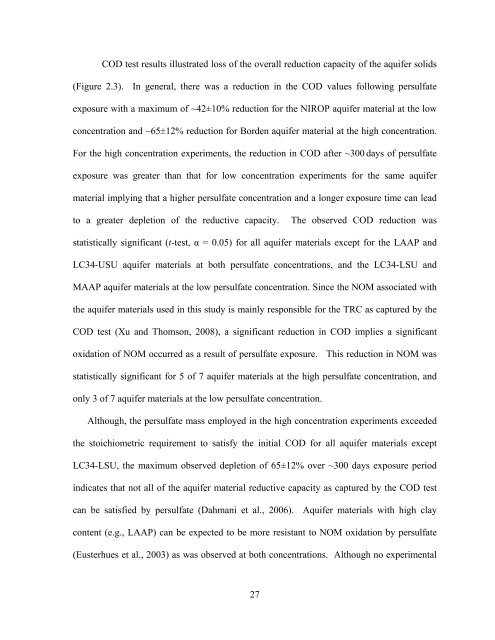Time (days) - UWSpace - University of Waterloo
Time (days) - UWSpace - University of Waterloo
Time (days) - UWSpace - University of Waterloo
You also want an ePaper? Increase the reach of your titles
YUMPU automatically turns print PDFs into web optimized ePapers that Google loves.
COD test results illustrated loss <strong>of</strong> the overall reduction capacity <strong>of</strong> the aquifer solids<br />
(Figure 2.3). In general, there was a reduction in the COD values following persulfate<br />
exposure with a maximum <strong>of</strong> ~42±10% reduction for the NIROP aquifer material at the low<br />
concentration and ~65±12% reduction for Borden aquifer material at the high concentration.<br />
For the high concentration experiments, the reduction in COD after ~300 <strong>days</strong> <strong>of</strong> persulfate<br />
exposure was greater than that for low concentration experiments for the same aquifer<br />
material implying that a higher persulfate concentration and a longer exposure time can lead<br />
to a greater depletion <strong>of</strong> the reductive capacity. The observed COD reduction was<br />
statistically significant (t-test, α = 0.05) for all aquifer materials except for the LAAP and<br />
LC34-USU aquifer materials at both persulfate concentrations, and the LC34-LSU and<br />
MAAP aquifer materials at the low persulfate concentration. Since the NOM associated with<br />
the aquifer materials used in this study is mainly responsible for the TRC as captured by the<br />
COD test (Xu and Thomson, 2008), a significant reduction in COD implies a significant<br />
oxidation <strong>of</strong> NOM occurred as a result <strong>of</strong> persulfate exposure. This reduction in NOM was<br />
statistically significant for 5 <strong>of</strong> 7 aquifer materials at the high persulfate concentration, and<br />
only 3 <strong>of</strong> 7 aquifer materials at the low persulfate concentration.<br />
Although, the persulfate mass employed in the high concentration experiments exceeded<br />
the stoichiometric requirement to satisfy the initial COD for all aquifer materials except<br />
LC34-LSU, the maximum observed depletion <strong>of</strong> 65±12% over ~300 <strong>days</strong> exposure period<br />
indicates that not all <strong>of</strong> the aquifer material reductive capacity as captured by the COD test<br />
can be satisfied by persulfate (Dahmani et al., 2006). Aquifer materials with high clay<br />
content (e.g., LAAP) can be expected to be more resistant to NOM oxidation by persulfate<br />
(Eusterhues et al., 2003) as was observed at both concentrations. Although no experimental<br />
27

















